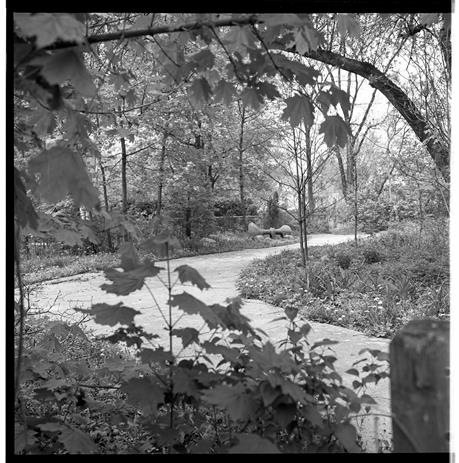History
Ann Arbor's city parks sit on the ancestral and traditional homelands of several indigenous Native peoples. Read a
land acknowledgement from the city and learn more about the early history of the land
here.
The land was folded into the city of Ann Arbor proper in 1891 as a parcel in the College Hill Addition. It was purchased as part of a big wooded corner lot by
Anne B. Mueller (maiden name Charlotte Agnes "Annie" Belger), a pioneer journalist, and her husband
Fredrick E. Mueller, one of the first printers to enter the linotype field, early in their marriage. They were among the first residents on Vinewood Boulevard. Despite the area developing around them, they tried to keep their land in a natural state. Sometime after her husband's death in 1937, Mrs. Mueller sold part of the big lot to some people to build a home. Mrs. Mueller passed away in 1965, at age 85 Following her death, her lot with her
wildflower garden and tree-shrouded “rough box" of a home was deeded to the city for a park.
It was dedicated for park purposes in June 1966 when neighbor, friend, and first woman city council member Margret D. Towsley — acting on the intentions of deceased Anne Mueller — signed over to the city a quit claim deed for the land. This park is a posthumous thank-you note to the neighborhood's postmen.
In a letter to city council, Towsley said, “This lot was for many years the location of the residence of Anne B. Mueller. During many of these years, it was the habit of the postman delivering mail in the area to stop in to check on the condition of Mrs. Mueller who lived alone. It is requested that the park to be established be called 'Postman's Stop' and dedicated to the unselfish mail carriers throughout the years who have devoted so much time in the service of others. It would have made Mrs. Mueller very happy to have been able to make this dedication herself."

Postman's Rest Park, May 1972, courtesy AADL.
Towsley was later quoted as saying: "We don't half appreciate the value of a friendly postman, what he can do for a neighborhood if he takes a little interest in it. Bob (the neighborhood postman at the time and one of the postmen who had looked in on Mrs. Mueller) always tells us if someone on the route is sick or having difficulties, just manages to let us know he's a little worried about someone." Mrs. Mueller was cared for by neighbors, particularly Towsley, and received short daily visits from city postmen who took a personal interest in her welfare.
The house was torn down but the park was named as a tribute to Norm Kern and Bob Schlupe, the mail carriers who stopped each day to see that "Annie" was all right. Norm Kern stopped by each day to check on her; when he retired, his replacement Bob Schlupe did the same.
There is no word or short phrase in the English language that conveys the simple act of kindness that was performed over and over again. "Neighborliness" comes close in spirit, but not exactly fitting when the person offering the "neighborliness" is the postman, not a neighbor. This lack of language for quickly conveying the appropriate meaning is perhaps the reason this park has undergone change in its name, being initially called "Postman's Stop", sometimes "Postman's Park", and apparently by 1972 "Postman's Rest Park." Capturing the underlying act of kindness with just the right word or phrase has proven elusive, at least in English.
A 1903 U-M graduate, Anne Mueller was a
pioneering journalist and "liberated woman" who was adept at making do with little and undaunted by what others might make of her appearance. With just modest Social Security income, living in a small home she called “the rough box", and having no family to care for her as she aged, she lived an apparently contented life to age 85. The parcel of land now carrying the name "Postman's Rest Park" holds memories of her love of a little wild spot, books, and the absence of any semblance of order.
This history is from Martha Hill's History of Postman's Rest Park.
